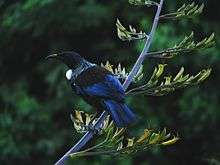Phormium tenax
| Phormium tenax | |
|---|---|
 | |
| A flax plant with tall flower stems | |
| Scientific classification | |
| Kingdom: | Plantae |
| Clade: | Angiosperms |
| Clade: | Monocots |
| Order: | Asparagales |
| Family: | Xanthorrhoeaceae |
| Subfamily: | Hemerocallidoideae |
| Genus: | Phormium |
| Species: | P. tenax |
| Binomial name | |
| Phormium tenax J.R.Forst.. & G.Forst. | |

Phormium tenax (called flax in New Zealand English; harakeke in Māori; New Zealand flax[1] outside New Zealand; and New Zealand hemp[1] in historical nautical contexts) is an evergreen perennial plant native to New Zealand and Norfolk Island that is an important fibre plant and a popular ornamental plant.[2] The plant grows as a clump of long, straplike leaves, up to two metres long, from which arises a much taller flowering shoot, with dramatic yellow or red flowers.[2]
The fibre has been widely used since the arrival of Māori to New Zealand, originally in Māori traditional textiles and also in rope and sail making[3] after the arrival of Europeans up until at least WWII. It is an invasive species in some of the Pacific islands and in Australia.[4]
The blades of the plant contain cucurbitacins, which are poisonous to some animals, and some of them are among the bitterest tastes to humans.[5]
Ecology
The jumping spider Trite planiceps lives predominantly in the rolled-up leaves of this species. Phormium tenax is a coastal cover plant associated with significant habitat such as the breeding habitat for the endangered yellow-eyed penguin.[6]
Cultivation
Phormium tenax had many uses in traditional Māori society, but most of these have fallen into disuse. The leaves stripped and dried before being woven. Its primary use today is for the weaving of kete (flax baskets).
Prior to the Great Depression of the 1930s, which decimated flax as an industry, there were two serious attempts by Europeans to breed for fibre. The first was by Wellington-based Leonard Cockayne about 1908.[7] The second by Massey-based John Stuart Yeates in the late 1920s.[8][9]
In recent times, P. tenax and its cousin P. cookianum have been widely cultivated as ornamental garden plants, their striking fans of pointed leaves providing a focal point in mixed plantings or at the edge of a lawn. They are easy to grow in a sunny spot, especially in coastal areas with some protection in winter, but require reliably moist soil. They are frequently found in garden centres amongst plants with a similar appearance, notably Yucca and Cordyline. However, these are very different plants with different requirements. P. tenax and some cultivars can grow to a substantial size - 4 m (13 ft) tall by 2 m (7 ft) broad.[10]
New Zealand Flax was cultivated on Saint Helena from the late 1800s to around 1966 for the production of string and rope and for export.[11] Today the plants remain but the industry has stopped; they are considered an ecological problem.[12]
Cultivars
More recently several cultivars have been selected as decorative garden plants, including:[13]
- 'Bronze Baby' - arching bronze leaves, 2-to-3-foot (0.61 to 0.91 m) plant.
- 'Dazzler' - arching leaves that are bronze-maroon with red and pink stripes, plant reaches 3 feet in height
- 'Duet'agm[14]
- 'Sundowner'agm[15] - 6-foot-tall (1.8 m) plant, leaves are striped with bronze, green and rose-pink
- 'Variegatum'agm[16]
- 'Yellow Wave'agm[17]
Those marked agm have gained the Royal Horticultural Society's Award of Garden Merit.
See also
- Phormium, covering both species
- Flax in New Zealand
References
- 1 2 "USDA GRIN Taxonomy".
- 1 2 Roger Holmes and Lance Walheim. 2005. California Home Landscaping, Creative Homeowner Press ISBN 978-1-58011-254-3
- ↑ http://www.nzetc.org/tm/scholarly/tei-Gov09_02Rail-t1-body-d7-d2.html
- ↑ "Phormium tenax (PIER species info)". Pacific Island Ecosystems at Risk (PIER). 9 January 2011. Retrieved 20 August 2012.
- ↑ "New cucurbitacins from Phormium tenax and Marah oreganus". Phytochemistry 17: 767–769. doi:10.1016/S0031-9422(00)94223-7.
- ↑ C. Michael Hogan. 2009. Yellow-eyed Penguin: Megadypes antipodes, GlobalTwitcher.com, ed. N. Stromberg
- ↑ http://paperspast.natlib.govt.nz/cgi-bin/paperspast?a=d&cl=search&d=DOM19080507.2.60
- ↑ http://paperspast.natlib.govt.nz/cgi-bin/paperspast?a=d&cl=search&d=EP19291221.2.108
- ↑ http://paperspast.natlib.govt.nz/cgi-bin/paperspast?a=d&cl=search&d=EP19300920.2.20
- ↑ RHS A-Z encyclopedia of garden plants. United Kingdom: Dorling Kindersley. 2008. p. 1136. ISBN 1405332964.
- ↑ http://sainthelenaisland.info/flax.htm
- ↑ http://sainthelenaisland.info/endemics.htm
- ↑ Frances Tenenbaum. 2003. "Taylor's Encyclopedia of Garden Plants", Houghton Mifflin Company ISBN 0-618-22644-3
- ↑ "RHS Plant Selector - Phormium 'Duet'". Retrieved 30 June 2013.
- ↑ "RHS Plant Selector - Phormium 'Sundowner'". Retrieved 30 June 2013.
- ↑ "RHS Plant Selector - Phormium tenax 'Variegatum'". Retrieved 30 June 2013.
- ↑ "RHS Plant Selector - Phormium 'Yellow Wave'". Retrieved 30 June 2013.
Further reading
- James Hector. 1889. Phormium tenax as a fibrous plant, second edition, New Zealand. Geological Survey Dept, New Zealand, published by G. Didsbury, Government Printer, 95 pages
External links
| Wikimedia Commons has media related to Phormium tenax. |